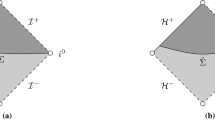Abstract
The fact that one must evaluate the near-extremal and near-horizon limits of Kerr spacetime in a specific order, is shown to lead to discontinuity in the extremal limit, such that this limiting spacetime differs nontrivially from the precisely extremal spacetime. This is established by first showing a discontinuity in the extremal limit of the maximal analytic extension of the Kerr geometry, given by Carter. Next, we examine the ISCO of the exactly extremal Kerr geometry and show that on the event horizon of the extremal Kerr black hole, it coincides with the principal null geodesic generator of the horizon, having vanishing energy and angular momentum. We find that there is no such ISCO in the near-extremal geometry, thus garnering additional support for our primary contention. We relate this disparity between the two geometries to the lack of a trapping horizon in the extremal situation.
Similar content being viewed by others
References
P. Pradhan, P. Majumdar, Phys. Lett. A 375, 474–479 (2011). arXiv:1001.3582 [gr-qc]
S. Das, A. Dasgupta, P. Ramadevi, Mod. Phys. Lett. A 12, 3067 (1997). arXiv:hep-th/9608162
S.M. Carroll, M.C. Johnson, L. Randall, J. High Energy Phys. 0911, 109 (2009). arXiv:0901.0931
R.M. Wald, Phys. Rev. D 48, 3427 (1993)
A. Sen, Int. J. Mod. Phys. A 24, 4225 (2009), and references therein; arXiv:0809.3304v2
J.M. Bardeen, W.H. Press, S.A. Teukolsky, Astrophys. J. 178, 347–369 (1972)
S. Chandrashekar, The Mathematical Theory of Black Holes (Clarendon, Oxford, 1983)
B. Carter, Phys. Rev. Lett. 141(4), 1242 (1966)
B. Carter, Phys. Rev. Lett. 174(5), 1559 (1968)
T. Jacobson, Class. Quantum Gravity 28, 187001 (2011)
C. Doran, Phys. Rev. D 61, 067503 (2000)
T. Harada, M. Kimura, Phys. Rev. D 83, 024002 (2011)
C.W. Misner, K.S. Thorn, J.A. Wheeler, Gravitation (Freeman, New York, 1973)
Author information
Authors and Affiliations
Corresponding author
Appendix: Maximal analytical extension of Kerr spacetime (off axis of symmetry)
Appendix: Maximal analytical extension of Kerr spacetime (off axis of symmetry)
The maximal analytic extension of the non-extremal Kerr spacetime along the off axis of symmetry was first reported by Carter [8]. As we showed for symmetry axis the analytic extension is not continuous at the extremal limit r +→r − in Sect. 3, here we implemented for the off axis symmetry and only derive the extremal case. For non-extremal case see Carter’s [8] paper.
The complete analytic extension of the extremal Kerr spacetime thus cannot be obtained as a limiting case of the non-extremal geometry as previously, one needs to treat the extremal case separately [8]. Defining the double null coordinates and angular coordinates we have
Define ignorable angle coordinates ϕ ⋆ given by
which are constant on the null generator of the horizon at r=M. The metric is thus given by
where \(\rho_{\star}^{2}=M^{2}(1+\cos^{2}\theta)\), Δ=(r−M)2, ρ 2=(r 2+M 2cos2 θ). r is now defined implicitly as a function of u and v by
where r ∗ is called the ‘tortoise’ coordinate, determined by
Integrating (A.5) yields
Near the horizon r=M this has a leading pole-type singularity
instead of a logarithmic one. To locate the event horizon at a finite region in the coordinate chart, we follow Ref. [8] and introduce null coordinates U, V such that
This implies that
Therefore the complete extremal Kerr metric in (U,V,θ,ϕ ⋆) is given by
It can easily be checked that in the limit θ=0 we obtain the metric (18) for the symmetry axis.
Rights and permissions
About this article
Cite this article
Pradhan, P.P., Majumdar, P. Extremal limits and Kerr spacetime. Eur. Phys. J. C 73, 2470 (2013). https://doi.org/10.1140/epjc/s10052-013-2470-2
Received:
Published:
DOI: https://doi.org/10.1140/epjc/s10052-013-2470-2




